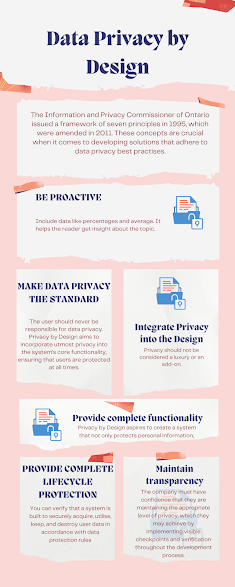What is the meaning of "Data Privacy by Design"
The delicate balance between cutting-edge technology and data privacy is becoming increasingly difficult to strike, especially as the software we use on a daily basis becomes more intelligent. The more personal data our apps collect, the more concerned we are about data security. So, how can we keep investing in smart software programmes that make life easier without jeopardising data security? Well, the concept of 'privacy by design' holds a major part of the answer.
The Individualised Experience
In many respects, personalised services and products have improved our lives. We have more personalised user experiences, we are more connected to the outside world, and we even trust technology to help us recall – and foresee – significant life events. However, as service providers, we must ensure that in order to deliver the benefits of these personalised solutions, we should not jeopardise customer privacy.
Designing for Data Privacy
Customers will generally trust your ability to carefully manage the data they give you if they trust your brand or product. However, data privacy must not be an afterthought when it comes to delivering on that trust. It should be incorporated throughout every stage of product development. This is why Privacy by Design is such an important consideration.

The Information and Privacy Commissioner of Ontario issued a framework of seven principles in 1995, which were amended in 2011. These concepts are crucial when it comes to developing solutions that adhere to data privacy best practises.
1. Be Proactive
Rather than being reactive or remedial, data privacy should always be proactive. This implies that you anticipate and plan for a breach of privacy before it occurs. Rather to dealing with problems as they arise – or after they have already occurred – Privacy by Design employs a risk analysis and mitigation methodology to keep the system safe in the first place.
2. Make Data Privacy the Standard
The user should never be responsible for data privacy. Privacy by Design aims to incorporate utmost privacy into the system's core functionality, ensuring that users are protected at all times. This should never necessitate the individual taking any explicit action to protect themselves; it should always be available by default.
3. Integrate Privacy into the Design
Privacy should not be considered a luxury or an add-on. It should be built into the core structure and design of the company's procedures. As a result, privacy can become an integrated feature, just like any other aspect of software design. Privacy should be attained without sacrificing or diminishing the amount of functionality available.
4. Provide complete functionality
Privacy by Design aspires to create a system that not only protects personal information, but also provides a great user experience and benefit. To put it another way, the solution should provide maximum value to the consumer without jeopardising their privacy. This method stimulates the development of solutions that do not merely eliminate features where data privacy may be difficult to implement. Instead, it puts pressure on developers to come up with solutions that provide the same or better value while still respecting the privacy of users.
5. Provide complete life-cycle protection
You can verify that a system is built to securely acquire, utilise, keep, and destroy user data in accordance with data protection rules by incorporating data privacy into every stage of development. This lays the groundwork for secure end-to-end processing of user data without the need to patch together multiple data management systems.
6. Maintain transparency
Privacy by Design relies heavily on transparent visibility. The company must have confidence that they are maintaining the appropriate level of privacy, which they may achieve by implementing visible checkpoints and verification throughout the development process. This allows everyone to have confidence in the final product's ability to safely manage any personal information.
7. Keep the user in mind.
The firm must prioritise the user's needs and respect for their privacy at every level. After all, it's this that will determine if you can advertise and operate the solution successfully. You and your clients may be confident that privacy is securely incorporated into the fundamental structure of the application with a backbone of best practise across the whole development process.
Implementing Best Practices
Every software project should have data privacy best practises at its core. As we add more tailored functionality that relies on user data, we must be increasingly cognizant of not only regulatory requirements but also the real, concrete risk that a data breach poses to the user. We can help users trust how applications and websites use their information by adding these key building pieces into our development initiatives.
The notions of Privacy by Design and Default encourage compliance with data protection laws and regulations from the outset of personal data efforts. The principles of privacy by design and default, which were first articulated by the Canadian Privacy Commissioner of Ontario in the 1990s, have recently been adopted by regulators all over the world as key components of privacy protection.
Following privacy by design principles can be used to help assure full compliance with data protection standards as needed by law, despite potentially putting extra burden on the conception and development of new projects.
It can lead to the identification of potential privacy issues at an earlier and less costly stage, as well as an increase in knowledge of privacy and data protection issues throughout a company.
There is no formal obligation in the present EU Data Protection Directive (DPD) to integrate privacy by design and privacy by default. While the DPD requires data controllers to put in place technical and organisational measures to protect personal data against illegal processing, this is only a footnote because it only applies to data that has already been processed.
Privacy by default
specification of purpose- describing how personal data is gathered, processed, stored, and disclosed to users.
Restriction on collection- just, lawful, and limited to what is required (also applies to data processing, retention, and disclosure).
Minimising of data- As a default, non-identifiable interactions and transactions. Personal information should be as unidentifiable as practicable whenever possible.
Every firm is affected by data security and privacy concerns. Our Multidisciplinary team can help with the GDPR, data breaches, international data transfers and BCRs, privacy risk management, and cross-border compliance.
Legal Services in Amsterdam
Our Privacy & Data Protection team is here to assist you in navigating the complicated regulatory landscape. We have more than 12 years of expertise assisting you in finding practical, business-oriented solutions. We can assist you from the moment a new law is proposed through compliance programmes, privacy conflicts and litigation, and enforcement actions by authorities.
Legal help in Amsterdam will give you with reliable guidance on GDPR and other privacy legislation, data breaches, data transfer problems, and the use of cookies and online tracking.
To learn more about how we can Provide Legal Services Amsterdam, contact our top-rated team at Infinity Legal Solutions.


Comments
Post a Comment